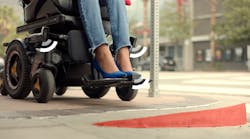Innovation is often the result of a passion. For brothers Barry and Jered Dean, the creation of LUCI was more than a passion – it was personal.
The brothers were driven and committed to create change for people living with disabilities. Barry’s daughter Katherine uses a power wheelchair, and the co-founders wanted to develop a way to improve Katherine's wheelchair and allow her more independence.
However, the initial impetus occurred when a family friend, who's in a similar type of power wheelchair, had an incident where they just misjudged a curb, tipped their chair and ended up severely injured, explains LUCI CTO Jered Dean. "Barry contacted me and said he was worried about Katherine's safety. She likes to drive around the neighborhood outside of the yard,” he says. It immediately prompted discussion around how to make sure she is safe and has the independence that she loves.
The result is LUCI, the first commercially available add-on designed to transform an existing power wheelchair into a smart device.
To accomplish this goal, LUCI leverages an array of smart technologies – essentially adding a brain, sensors and connectivity that listens to the input from the user, looks at the surroundings and connects them to the modern world.The technology LUCI adds is a combination of stereo-vision radar ultrasonic sensors to effectively map the world. It also has an arm compute module and a series of IoT connectivity modules.
Preventing tips, falls and collisions. Solving this goal resulted in a large push to find sensors that can work in the environment wheelchairs are used in, which is everywhere. “Unfortunately, we don't have a nice floor plan for all the places riders are going to be,” says Dean. “It's a little unique versus say a factory robot setting where you can have maps and beacons. Or even an autonomous vehicle setting where you can leverage road markings and maps. We worked with a couple of partners and actually ended up developing our own radars and ultrasonics specifically for this application.”
Connecting to the modern world. “We knew Wi Fi was not enough, and not all wheelchair users have smartphones. And it isn’t right to have smartphone ownership as a prerequisite for the type of technology inclusion LUCI provides this population,” says Dean. “A truly connected chair needed to be connected all the time, as much as possible so riders can focus on exploring their world, with confidence, and being connected back to their support team. Life is a team sport. For instance, Katherine has an aide, family members, therapists and doctors. All these people are involved to help Katherine live with as much independence as possible. That's what LUCI's connectivity is really built for.”
It uses a cloud-connected Internet of Medical Things (IoMT) solution that can be integrated into two-thirds of the power wheelchairs currently on the market. It also allows users to receive help quickly if they do have an accident, by notifying the user’s emergency contacts. To do this, LUCI needs to extract data from the wheelchair and sensors, and then securely transmit this data to the cloud. To do all of this while not draining the wheelchair’s battery, which is also used to power the wheelchair itself, it must use as little energy as possible.
The Low Power Wide Area (LPWA) module uses Cat-M and NB-IoT cellular networks to minimize the energy consumed by LUCI when it transmits data from the wheelchair to the cloud. The module’s compact CF3 design also allows the LUCI design team to easily migrate between different connectivity technologies, helping them future-proof their hardware platform.
LUCI can connect to different carriers – AT&T, T-Mobile, Verizon or Rogers networks in North America -- depending on which carrier provides the best coverage in a particular location. At the same time, Sierra Wireless’s Global Network Operation Center (GNOC) monitors these networks, preventing downtime and helping the LUCI team quickly resolve any connectivity issues.
"It's really a typical innovation process, transforming a physical asset into a smart asset. When considering wireless technologies, there's a lot of complexity not only for the implementation, but also for the user," Sierra Wireless Vice President of Product and IoT solutions Olivier Pauzet tells IndustryWeek. "Our goal is to remove the complexity and ensure that the communication technology is not a barrier. And our mission is to enable that by connecting LUCI to the cloud. That's why we have developed a range of modules."
Staying secure
Data security is understandably a major consideration built directly into the LUCI platform, explains Dean. “For example, there's no identified data stored on the LUCI unit. We've built some additional security into our system to make sure that we get that information securely up to the cloud in a HIPAA secure fashion,” he says. “The infrastructure is built in a fashion where the user is 100% in charge of anybody who sees any identified data.”
Security is also top of mind for Sierra Wireless. “There's a lot of things that we do within the communication module to secure data (best-in-class internal security, secure boot encryption mechanisms, secure key storage, etc.) knowing it is a gateway the external world and the cloud,” says Pauzet.
Road ahead
This is just the beginning of smart wheelchairs for people with disabilities, Dean tells IndustryWeek. “To date most of the technological progress for people with disabilities has come from large consumer product companies, outside of the assistive technology world,” he says. “It's time for assistive technology as a field to make a leap forward, and we hope we are the catalyst. We laid the foundation for a power wheelchair to become the smart connected hub for riders, connecting them to and allowing them to share their data as they choose to regarding health and wellness.”
LUCI is currently available nationwide through the same clinics wheelchair riders currently get their chars. The effort put into developing LUCI has not gone unnoticed. It has received numerous accolades including TIME magazine’s Best Inventions of 2020, Popular Science “Best of What’s New” featuring 100 greatest innovations of 2020 and Mobility Management magazine’s Product Award.






